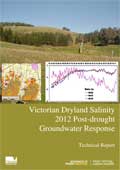Victorian Dryland Salinity 2012 - Post-drought Groundwater Response
Project background
The former DPI provided dryland salinity condition monitoring and reporting for catchments throughout Victoria. This is based upon monitoring of nearly 1700 bores, of which records from some go back over 30 years. The initial salinity occurrences that sparked the Salinity Action plans and Decade of Landcare in the 1980s and 1990s respectively caused serious land and water degradation issues. As a result of many successful Landcare and catchment programs, much was learned and done about salinity. The drought decade from 1998 to 2009 moderated recharge and reduced the severity and focus on dryland salinity.
Since 2009, two wet years have caused significant recharge to groundwater flow systems underlying salinity affected parts of the state. This report summarises the results of a detailed analysis of the available groundwater monitoring record for each CMA with the aim of providing a statewide summary of salinity status up to the end of 2011. It is intended that this will provide assistance to each CMA as they renew catchment strategies, with salinity planning able to draw upon the objective evidence of groundwater behaviour in the available monitored salinity provinces.
Contribution to objectives
The objectives this report seeks to achieve are to
- Utilise the bore monitoring data for dryland areas of Victoria to provide an objective indication of the behaviour of the groundwater systems that drive salinity discharge in salinity provinces in each CMA;
- Use the available observation bores to determine the magnitude of rebound in groundwater levels following the wet 2010-11 year to improve understanding of the responsiveness of salinity occurrence in the provinces;
- Improve understanding of the ability to monitor salinity condition in each province in each CMA;
- Help characterise the salinity severity in each province to enable subsequent salinity threat assessment to identified assets;
- Support the work of stakeholders in the former DSE, the CMAs, water authorities and regional communities in managing land and water resources and protecting productivity.
Method
The DPI dryland salinity bore database was analysed to identify all active bores around the state, and find bores that had records covering the post drought wetting period of 2009 to 2011. Of the 4534 bores that have at least one water level record, 1693 have bores covering the recent period. The bore data was categorised into three depth below surface ranges (< 2m, 2-5 m, and > 5m) from their summer-autumn 2011 data and tabulated and mapped. The second key indicator was a calculation of change in level between summer-autumn 2011 and summer-autumn 2009. This measure was categorised into greater than 1 m rise, little change (+/- <1m) and greater than 1 m decline in level. These results were also tabulated and mapped in each catchment. In compiling this report, hydrograph plots were also viewed to help understand long term behaviour pre-drought, drought response and post drought in different provinces.
Key findings, conclusions and recommendations
The majority of bores have registered a rise in watertable in response to the wet 2010-11 years, but the magnitude of rise has generally been less than 1 metre. Most discharge zone bores have remained within 2 metres of surface, or have rapidly returned to this range in the last 2 years.
Monitoring activity has declined markedly in several catchments, some to the point now where assessing salinity condition is not possible in many salinity provinces. Where monitoring is still active, the data record now provides a valuable data set for re-appraising the salinity hazard to land and water throughout the state. As CMAs renew their catchment strategies and consider how salinity should be incorporated post 2012, this report and the data behind it provides evidence of the current salinity threat.
| The full version of the Victorian Dryland Salinity 2012 - Post-drought Groundwater Response report is available as a PDF file, designed to be printed, and an accessible word processor document in DOC format. Victorian Dryland Salinity 2012 Post-drought Groundwater Response (PDF - 3 MB) To view the information PDF requires the use of a PDF reader. This can be installed for free from the Adobe website (external link) Victorian Dryland Salinity 2012 Post-drought Groundwater Response (DOC - 11 MB To view the information DOC requires the use of word processing software. |  Front cover of the Victorian Dryland Salinity 2012 - Post-drought Groundwater Response report |


